Please note: These pages are part of my RS 125 Workshop Page on my web blog and they are not related to the manufacturer Aprilia/Piaggio. These are self-written repair instructions, hints, tips and tricks for the old Aprilia RS 125 with two-stroke engine until year 2012. This blog is operated by a private individual without commercial background and without any benefits. There is absolutely no warranty. Any liability for any kind of damage that may be related to information from this website is totally denied. Use at your own risk.
There are several issues on the airbox that can be changed or have to be considered:
- Air filter mat pressure drop
- Air intake hose pressure drop
- Air box resonance
- Intake noise
There are totally different approaches and opinions on how to tune the air intake system, either the stock airbox gets optimized or everything gets changed to achieve maximum air flow. The reduction in pressure drop can be noticed at very high engine rpm (the pressure drop increases approximately as the square of the volume flow). The overall performance increase is still quite small, there is no magic trick to achieve lots of hp here.
Please note: Changing the air intake or air filter might void your vehicles license, log-book or registration, depending on your local laws. In the European union, any unapproved changes made on the air intake system without proper certification will void the homologation of the bike.
Replace filter mat
You can optimize the original air filter by replacing the filter mat with a filter mat with a lower flow resistance. Suitable air filter mats are available from TwinAir, Polini or Pipercross, and other manufacturers also offer universally suitable filter mats. The air filter mat installed as standard also actually does its job very well (subject: maintain standard condition).
How the airbox works
The air filter box is a dynamic system with a resonant frequency in which vibrations in the air filter are intentionally used. As soon as the amount of gas flowing to the carburetor decreases after the engine intake stroke, the moving air mass in the intake hose presses on the air volume in the air filter box due to its inertia, thereby increasing the pressure for the next intake stroke. This is called a resonator. By using those effects, energy which would otherwise be lost as noise is used and the overall noise of the bike is dramatically reduced.
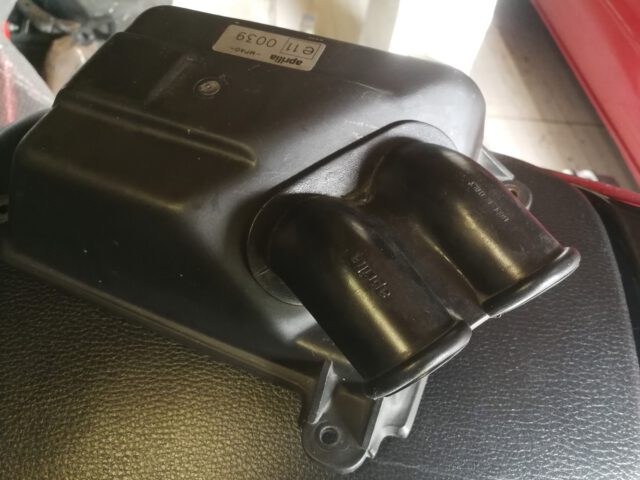
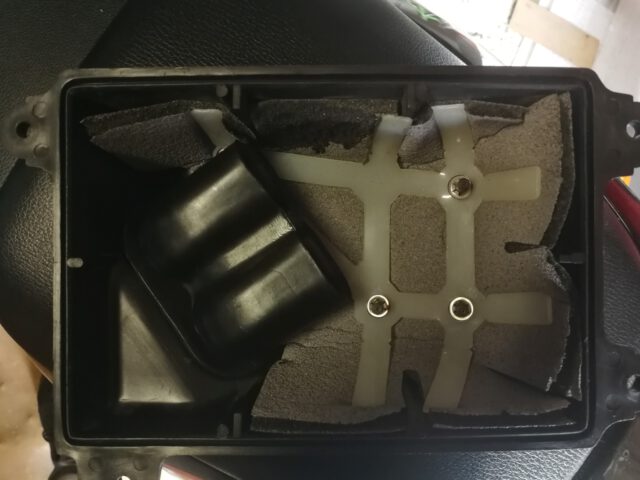
The intake sleeve therefore absorbs the noise by being part of the resonator. The whole air filter box can be described approximately using the formulas of a Helmholz resonator. The resonant frequency f is calculated from the speed of sound c, air filter volume V as well as length L, hydraulic diameter d (of one pipe) and total cross-section A of the intake sleeve as follows:
f = c / 2 / π ⋅ sqrt(A / V / (L + 0.8 ⋅ d))
This shows how the resonant frequency f, which characterizes the dynamics of the airbox, changes: Both increasing the cross-section A of the air intake hose and shortening the length L will lead to an increase in the resonant frequency.
Removing the intake manifold completely (“desnorkeling”) is not recommended, as the bike becomes noticeably noisy and runs significantly worse; power losses of approx. 1.5 kW (2 hp) was measured with a dyno run [1]. It also sounds kind of ch
Optimizing the stock air intake hose
The stock air intake hose has two openings with a total cross-section of about 690 mm² at the smallest point. The smallest cross-section in the 28 mm carburetor is 615 mm², but in the 34 mm carburetor it is 908 mm². For the 34-mm carburetor, it makes sense to modify the intake sleeve for the high rpm range.
The cross-section can be increased quite easily by cutting off the front part of the air intake hose and inserting the air intake hose into the air box the other way around. The smallest cross-section is then about 1200 mm², the air mass in the intake sleeve is thereby somewhat reduced but still present.
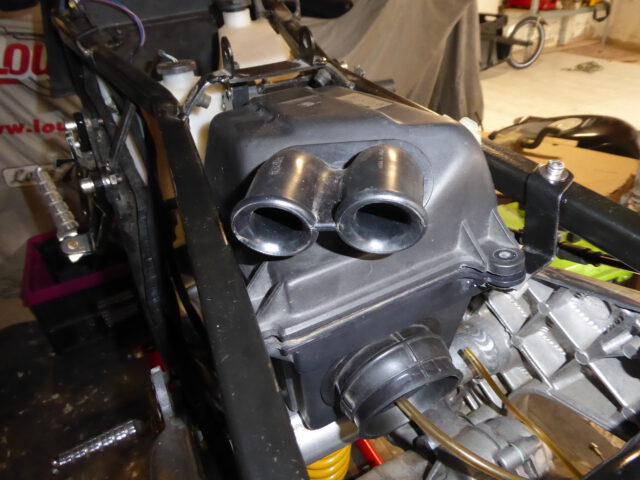
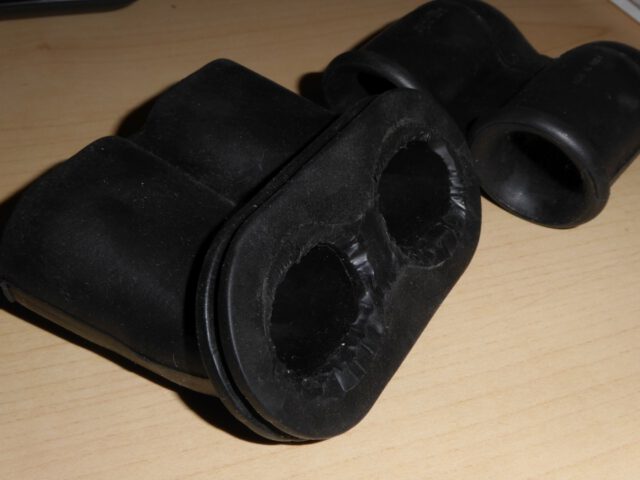
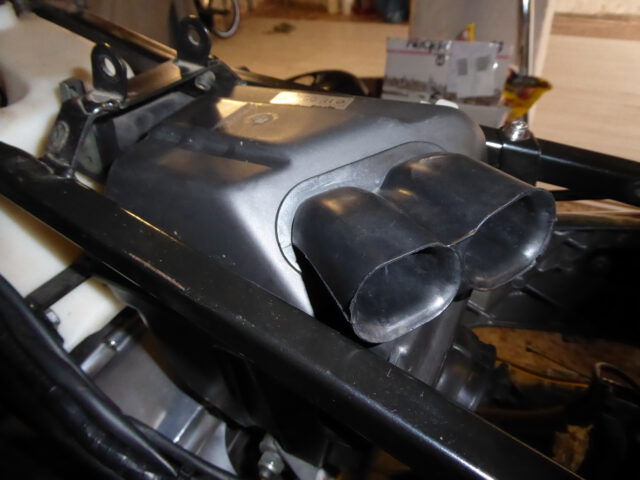
As already described, this action causes the resonant frequency of the air filter to increase sharply, and there may be a noticeable loss of power at low engine speeds.
Third party air intake hose
Some customizers have now produced their own intake hoses by using a 3D printer, which can be used instead of the original intake hose; these intake hoses are available from Abstract Racing or Morley Designs, for example. These intake sleeves have an extremely large cross-section.
Hartrusion air intake hose
I also developed an air intake hose myself, also made for 3D printing. It consists of two pipes like the stock part and uses two intake funnels at the inlet. The cross-section of each pipe is 680 mm², providing a total cross-section of 1360 mm². The shape is curved due to the small installation space at the air filter, in order to be able to draw in the air without any obstacle even when the fuel tank is lowered.
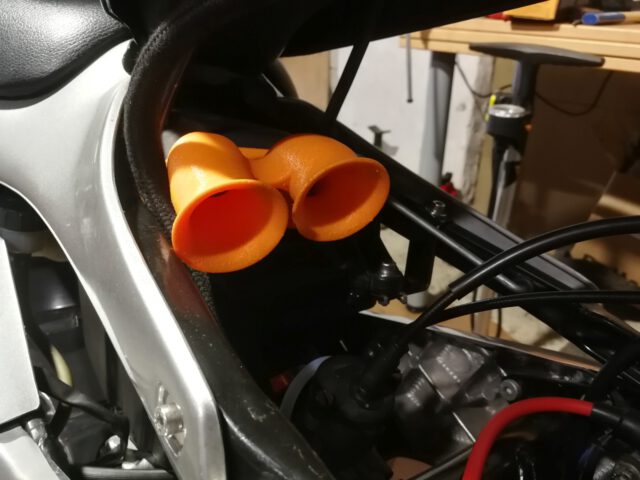
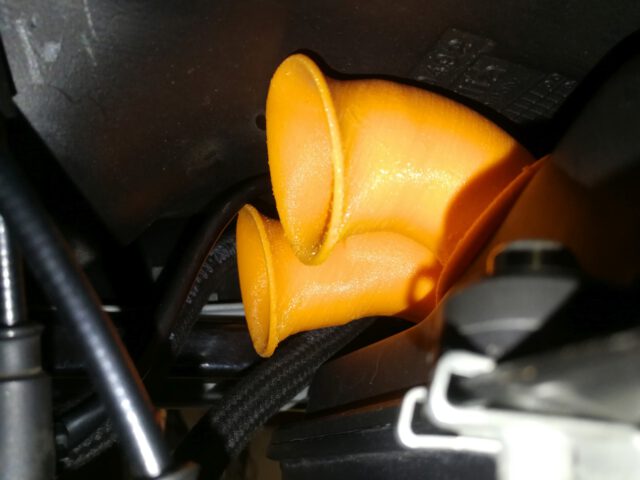
This air intake hose tries to keep the resonator frequency as close as possible to the frequency of the stock air filter to keep the characteristics and avoid interfering frequencies. Since the cross-section is much larger, the length of the hose had to be increased accordingly, which was generally difficult in the limited installation space.
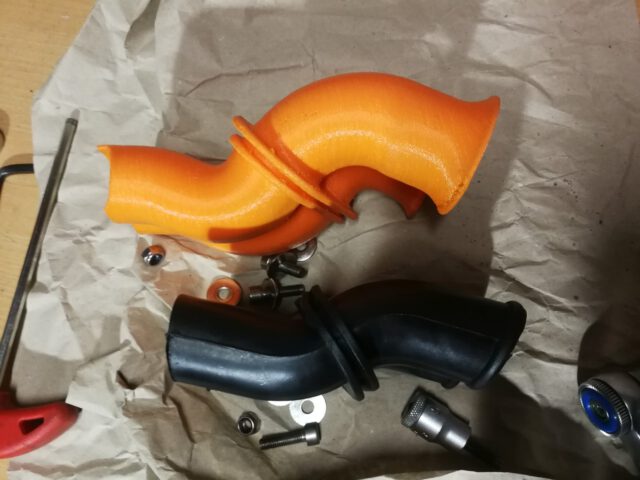
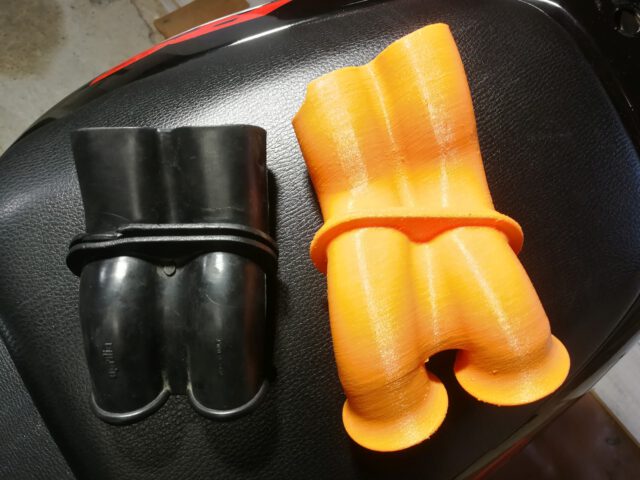
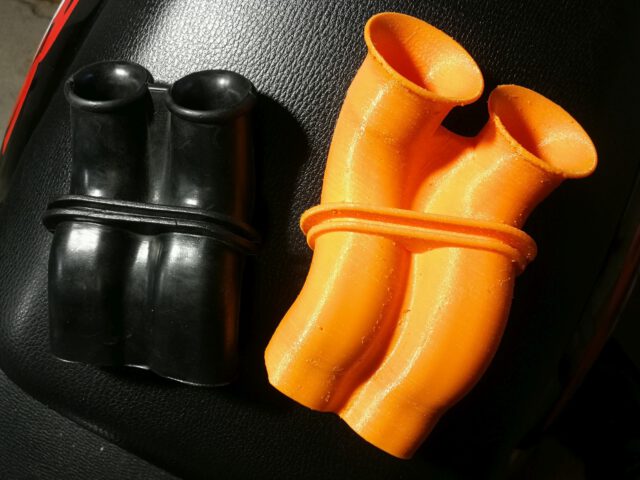
The length of the hose means that the intake noise is quieter, and initial tests also confirm that the resonator function continues to work, with good power delivery in the low and medium rpm range.
The strange-looking shape is due solely to the attempt to make optimum use of the available installation space without necessitating work on other parts.
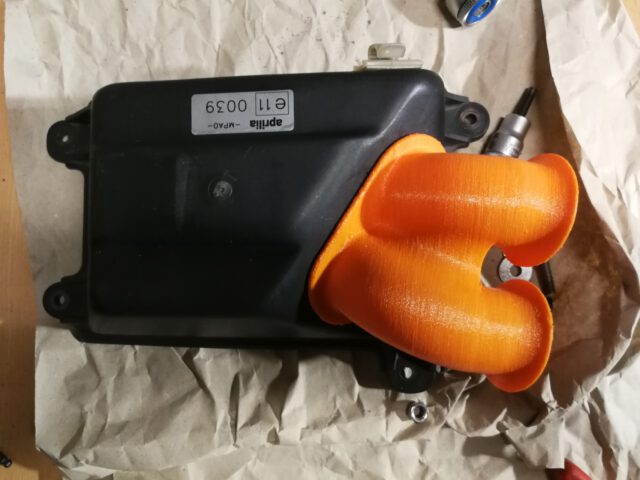
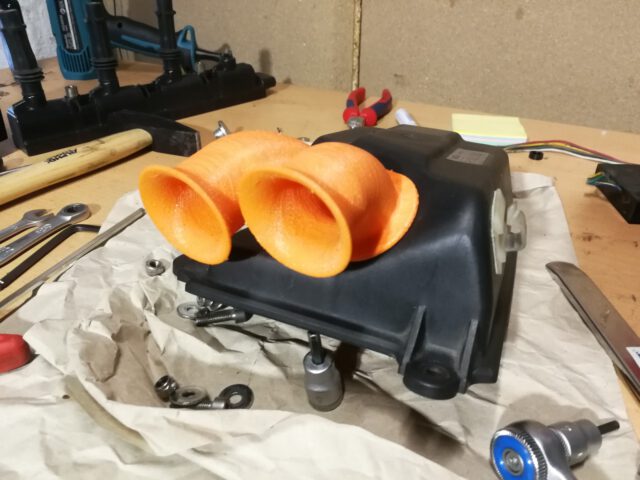

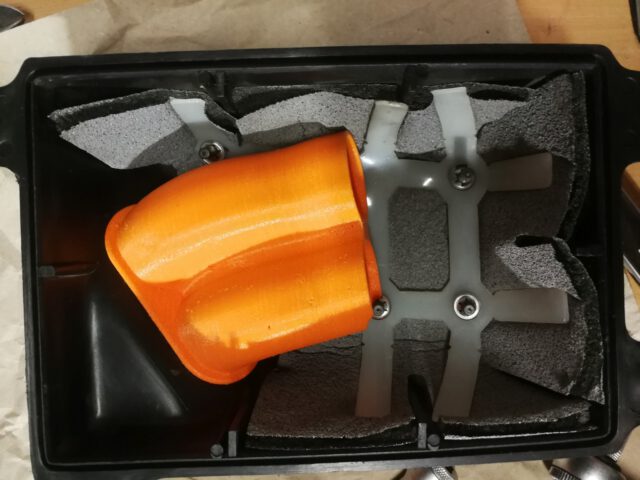
Someone who tested it provided me with some dyno data, this was tested using a DIY dyno with Ardyno on a RS 125 with 28 mm carburetor. There is a small increase in performance.
The intake sleeve must be printed using flexible material such as TPU (softer than 95A) and can be intalled plug & play into the air filter cover, without removing it.
You can download the STL file for printing here:
The small flat surface on the inner end has to be placed on the printer surface, those flaps and the end of the funnels have to be supported with some support structure. Try to avoid support structures between the flaps as they are painful to remove.
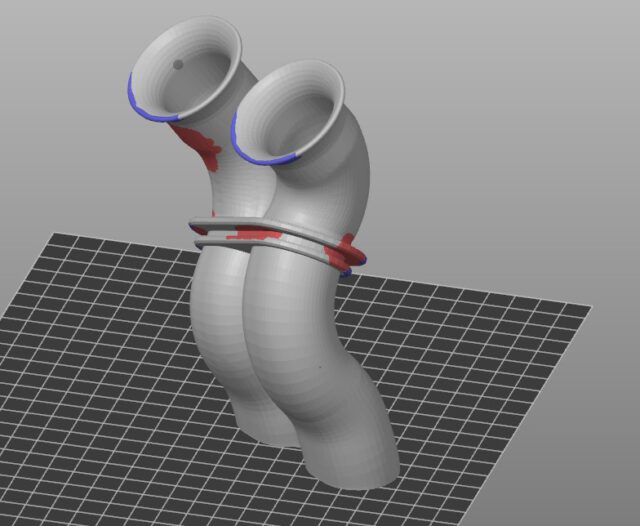
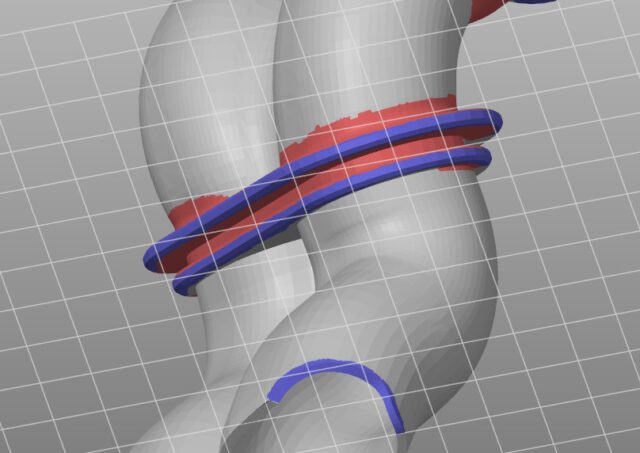



It is essential to use a very soft TPU for printing, simple TPU filaments with 95A hardness are still too hard. Usually a printer with direct extruder has to be used.
Bibliography
[1] EEKNOWS, “Airboxes R vs SP,” TZR Forum, Jan. 21, 2013. http://pure2strokespirit.net/forums/index.php?topic=512.msg5023#msg5023 (accessed May 29, 2021).

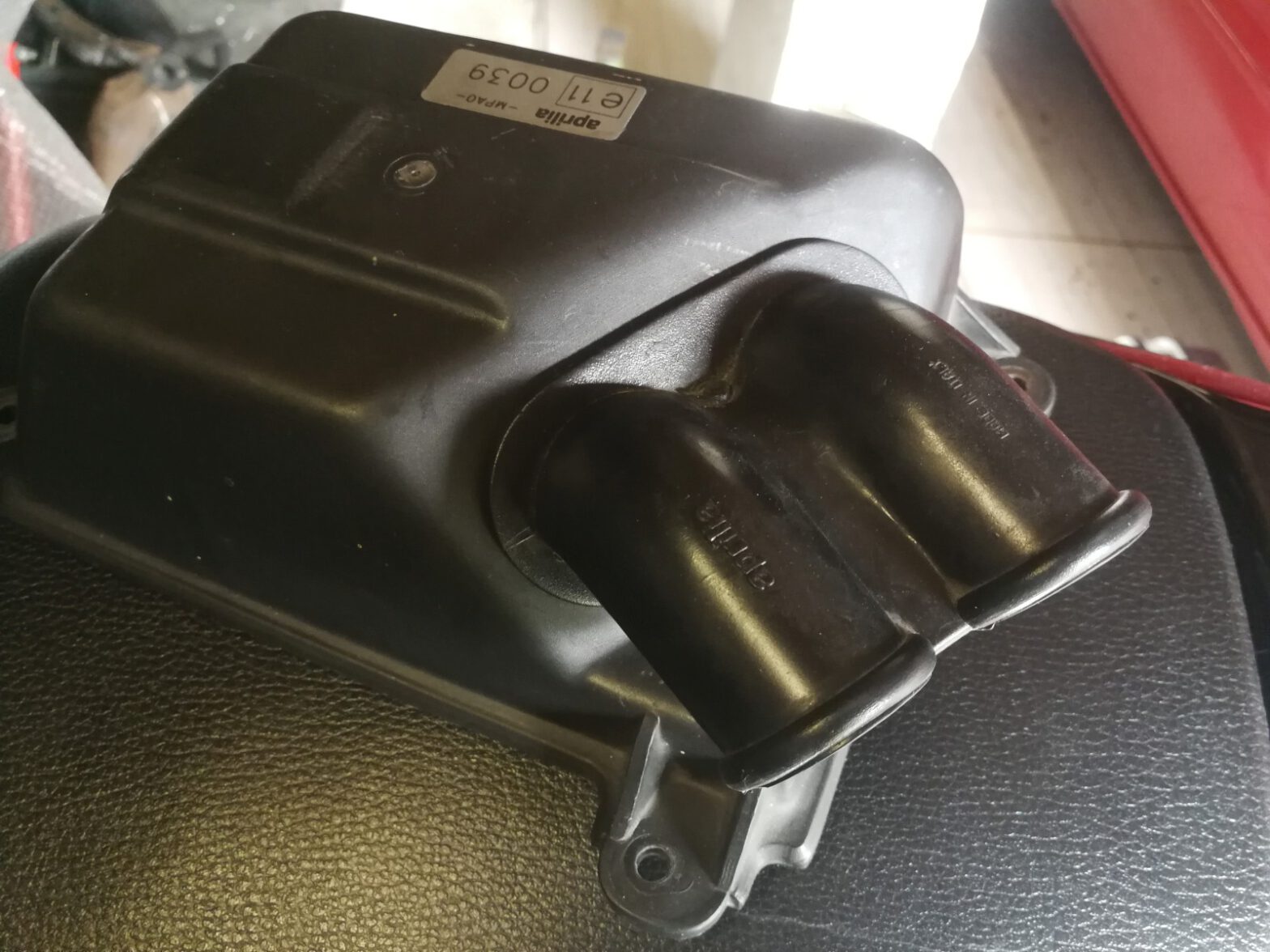
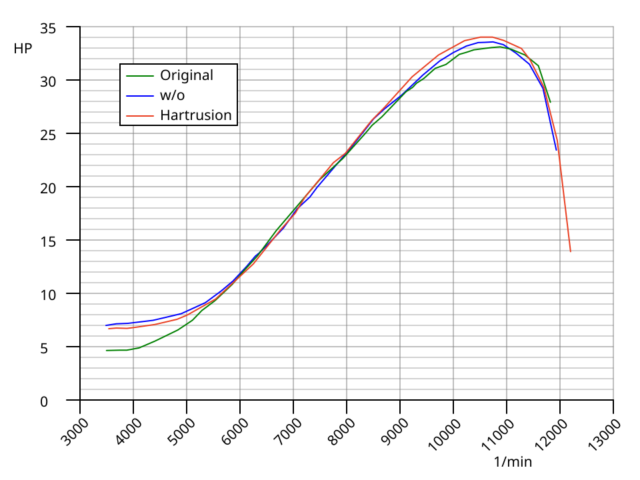
Hey, i like your work, how can i get that snorkel if i don’t have a 3d printer??
We made one large alumiunium intake, and joined it to the intake duct. Joining to the intake duct for ram air seemed to make the biggest difference – No idea why the route between intake and airbox wasn’t continued in the design phase.
Hi and thanks for the development of the new bigger snorkel.
I Bought my RS 125 -08 just a few weeks ago, and it was derestricted and fitted with an Mikata 140cc cylinderkit, VHM head (1mm squish), 34mm Dellorto, Arrow full system.
I felt like the bike does not run like it should, but I bought it anyway because it was cheap.
It runs very rich, taking over 1 liter per 10km of fuel on the highway (thats more than my GSXR1100 sportbike) It always starts cold without using any choke, and the power when riding is not the best. Last time I was out riding I could only hit 145km/h as max. I can see that the stock airbox snorkel is not mounted (but I have it). The carb are jetted with 160 mainjet. I will now try to 3Dprint your fine snorkel and also try 150 mainjet instead of 160. I hope it will run better.
For later project, I have bought a Italkit 140cc cylinder which I have ported slightly. “they” say that the Italkit 140 cylinder will rev more than the Mitaka 140cc, and there fore make more power. The Mitaka does not want to rev over about 10300rpm. The Italkit should rev to 11000-12000rpm like the stock 125cc Aprilia cylinder does.
Thanks again for your design. I will try print it with Ninjatek Cheetah (95A) or Ninjatek Ninjaflex (85A)
Is it not difficult to print vid soft 85A material when the snorkel is that high ?
I have so far no issues with printing very large parts with 85A material as it is also quite “wide” when printing. i highly recommend to dry the filament for 3 hours in an oven on 60 °C / 140 °F. Even if the filament is new and sealed it seems to dramatically increase printing performance. You need to use proper support structures as described in the article for this design but that should not be too difficult. I will add some pictures of how it should look in slicer in a few hours to that article. I have a report of someone who used 95A on this part and used heat and a screwdriver to push it into the airbox but that was not my initial intention 😉
Hi again Viktor!
This is a bit late reply but I want to inform you about my results 🙂
I was able to print the inlet snorkel in Ninjatek Ninjaflex 85A, no problems at all, and it was easy to install without heating it. So all good so far.
But I am sorry to say that the performance was not good, not with my setup anyway. I ran it with 34mm carb, 140cc Mikata cylinderkit, VHM insert (1mm squish) and 150 main jet.
With the stock inlet snorkel (both holes open, but not cut shorter) the engine runs smooth up to 8000rpm and the when the exaustvalve opens it pulls harder upp to about 10000rpm then loose power (due to the caracter of this Mikata 140cc cylinderkit).
With your snorkel design I can feel a big dip in power around 6000rpm, after 8000 to 10000rpm I feel similar power as with the stock snorkel, so I did put back the stock snorkel..
Now I have installed a Italkit 140cc kit instead that I also have ported a little. That kit is known to rev like the stock 125cc cylinder = up to 12000rpm. I will test the bike with stock and your snorkel with this setup, maybe it will work better? 🙂 🙂 Time will tell!
Best regards!
Nils
Hi Viktor!
This summer I have run a couple of tests with my new Italkit 140cc cylinder. Now I do not feel any dip around 6000rpm when using your inlethose/snorkel like I did with the Mikata 140cc cylinderkit for some reason.
A couple of days ago I tested to run with no snorkel, then with your snorkel, then with stock snorkel and I can not say than I feel any difference in the high powerband. Maybe there would be something if I went ro run it on a accual dyno 🙂 The inled sound is loud with no snorkel, and silent with both yours and stock snorkel.
I will do some more tests later on.
Thanks again!
Resonance calculated for standard inlet is about 3800rpm while it gaves good result at max power. do you know why it happens?
Hi, first of all, I’ve not checked what I’m going to write now so it might be wrong. Resonance means the system will accumulate all induced forces or pressure waves to oscillate on that frequency. There will be a phase shift in higher frequency between pressure frequency coming from the carburetor to the frequency of the resonating air box, this creates the effect which is needed here. But there will also be a lot of practice and try & error